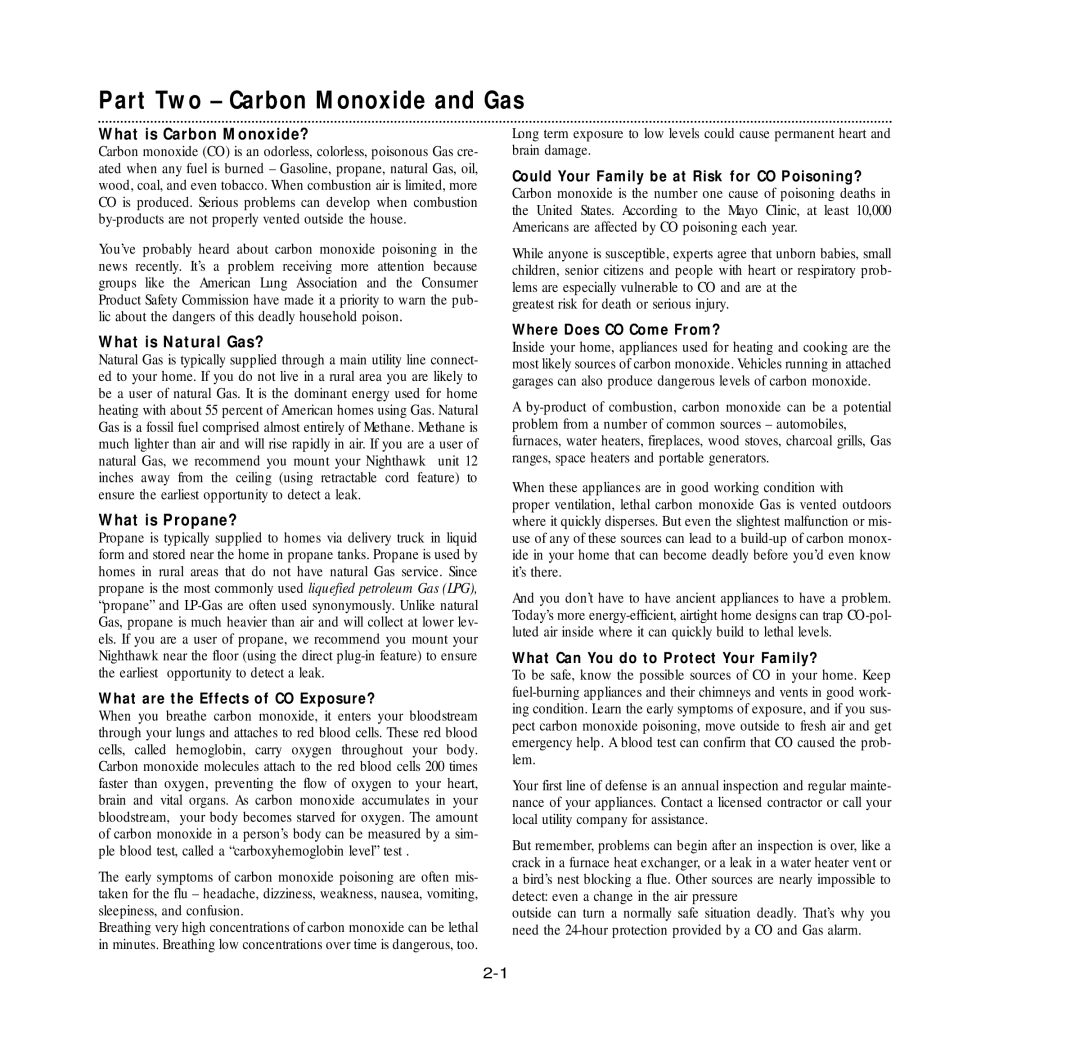What is Carbon Monoxide?
Carbon monoxide (CO) is an odorless, colorless, poisonous Gas cre- ated when any fuel is burned – Gasoline, propane, natural Gas, oil, wood, coal, and even tobacco. When combustion air is limited, more CO is produced. Serious problems can develop when combustion by-products are not properly vented outside the house.
You’ve probably heard about carbon monoxide poisoning in the news recently. It’s a problem receiving more attention because groups like the American Lung Association and the Consumer Product Safety Commission have made it a priority to warn the pub- lic about the dangers of this deadly household poison.
What is Natural Gas?
Natural Gas is typically supplied through a main utility line connect- ed to your home. If you do not live in a rural area you are likely to be a user of natural Gas. It is the dominant energy used for home heating with about 55 percent of American homes using Gas. Natural Gas is a fossil fuel comprised almost entirely of Methane. Methane is much lighter than air and will rise rapidly in air. If you are a user of natural Gas, we recommend you mount your Nighthawk unit 12 inches away from the ceiling (using retractable cord feature) to ensure the earliest opportunity to detect a leak.
What is Propane?
Propane is typically supplied to homes via delivery truck in liquid form and stored near the home in propane tanks. Propane is used by homes in rural areas that do not have natural Gas service. Since propane is the most commonly used liquefied petroleum Gas (LPG), “propane” and LP-Gas are often used synonymously. Unlike natural Gas, propane is much heavier than air and will collect at lower lev- els. If you are a user of propane, we recommend you mount your Nighthawk near the floor (using the direct plug-in feature) to ensure the earliest opportunity to detect a leak.
What are the Effects of CO Exposure?
When you breathe carbon monoxide, it enters your bloodstream through your lungs and attaches to red blood cells. These red blood cells, called hemoglobin, carry oxygen throughout your body. Carbon monoxide molecules attach to the red blood cells 200 times faster than oxygen, preventing the flow of oxygen to your heart, brain and vital organs. As carbon monoxide accumulates in your bloodstream, your body becomes starved for oxygen. The amount of carbon monoxide in a person’s body can be measured by a sim- ple blood test, called a “carboxyhemoglobin level” test .
The early symptoms of carbon monoxide poisoning are often mis- taken for the flu – headache, dizziness, weakness, nausea, vomiting, sleepiness, and confusion.
Breathing very high concentrations of carbon monoxide can be lethal in minutes. Breathing low concentrations over time is dangerous, too.
Long term exposure to low levels could cause permanent heart and brain damage.
Could Your Family be at Risk for CO Poisoning? Carbon monoxide is the number one cause of poisoning deaths in the United States. According to the Mayo Clinic, at least 10,000 Americans are affected by CO poisoning each year.
While anyone is susceptible, experts agree that unborn babies, small children, senior citizens and people with heart or respiratory prob- lems are especially vulnerable to CO and are at the
greatest risk for death or serious injury.
Where Does CO Come From?
Inside your home, appliances used for heating and cooking are the most likely sources of carbon monoxide. Vehicles running in attached garages can also produce dangerous levels of carbon monoxide.
A by-product of combustion, carbon monoxide can be a potential problem from a number of common sources – automobiles, furnaces, water heaters, fireplaces, wood stoves, charcoal grills, Gas ranges, space heaters and portable generators.
When these appliances are in good working condition with
proper ventilation, lethal carbon monoxide Gas is vented outdoors where it quickly disperses. But even the slightest malfunction or mis- use of any of these sources can lead to a build-up of carbon monox- ide in your home that can become deadly before you’d even know it’s there.
And you don’t have to have ancient appliances to have a problem. Today’s more energy-efficient, airtight home designs can trap CO-pol- luted air inside where it can quickly build to lethal levels.
What Can You do to Protect Your Family?
To be safe, know the possible sources of CO in your home. Keep fuel-burning appliances and their chimneys and vents in good work- ing condition. Learn the early symptoms of exposure, and if you sus- pect carbon monoxide poisoning, move outside to fresh air and get emergency help. A blood test can confirm that CO caused the prob- lem.
Your first line of defense is an annual inspection and regular mainte- nance of your appliances. Contact a licensed contractor or call your local utility company for assistance.
But remember, problems can begin after an inspection is over, like a crack in a furnace heat exchanger, or a leak in a water heater vent or a bird’s nest blocking a flue. Other sources are nearly impossible to detect: even a change in the air pressure
outside can turn a normally safe situation deadly. That’s why you need the 24-hour protection provided by a CO and Gas alarm.

